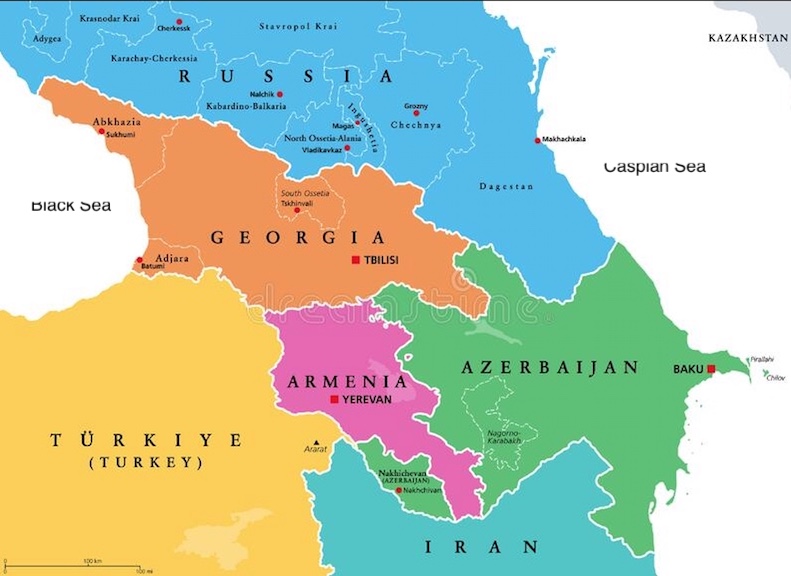

The word is out: in the Fall of 2022 the most hard core of super-travelers will be gathering in Yerevan, Armenia for the Extraordinary Travel Festival. Attending will be those who have been to or are striving to visit all 193 UN countries (266 counting territories, 1301 when divided into regions). In comparison, at 153 UN under my belt (199 including territories) I am but a tyro.
As long as I am making the effort, I might as well build a trip around it. Last year I visited all 7 North Caucuses republics that are part of the Russian Federation. In my 1996 visit to The USSR I went to all three trans-Caucuses republics; now they are post-Soviet and genuinely independent, under the "rules” of country counting I no longer get to include them so might as well plan a re-visit.
I start in Baku, capital of Azerbaijan. The Caspian region has been a major petroleum producer for over a century: its oil fields fueled the Red Army in WWII and were the ultimate objective of the Stalingrad campaign. I remember a grey, dingy city with few sights apart from Communist monuments. Just offshore, drilling derricks protruded from the polluted waters. Well, no more. Now that the oil wealth no longer goes to Moscow, a shiny new city has arisen.
Our hotel is located in the Flame Towers, aptly-named hilltop buildings dominating the skyline, where we have a room with a view.
|
|
|
The old, walled city, which was not even on the itinerary last time, has been nicely restored. The palace of the former Shah is now a museum. The
12th Century Maiden Tower is the signature landmark of the old city.
|
|
|
|
|
At night the Caspian waterfront is aglow while the towers come alive with a light show alternating various colors and a pattern mimicking dancing flames.
|
|
|
The next day we meet the guide we’ve hired for a four-day private tour. We start with Martyrs' Lane (f/k/a Kirov Park), a cemetery dedicated to those fallen in the ongoing conflict with neighboring Armenia.
|
|
|
Then the Carpet Museum, housed in a building shaped like a rolled rug.

|
|
|
A return the the old city to catch what we missed the day prior.
|
|
|
The spectacular Heydar Aliyev Center. Depending on where you stand, the building takes on many faces.
|
|
|
The interior contains an odd assortment of a marionette museum, a photographic exhibition, a collection of scale models of notable buildings in Baku, a hagiographic museum of the eponymous first president of Azerbaijan and a display of his various official cars.
|
|
|
|
|
The next day we drive just out of town to the Zorastian Fire Temple. Natural gas seeping through fissures ignited and created a perpetual flame which became a pilgrimage site. The site has been greatly expanded, but still is about the only place that is recognizable from my last visit.
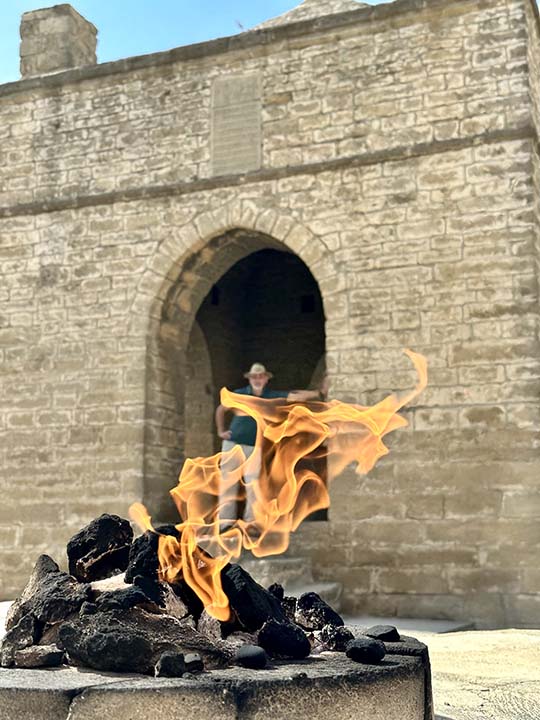
On the way back to the city we come across a patriotic celebration dedicating a memorial to a local hero who died in the 2020 round of fighting.
|
|
|
The conflict in a nutshell: during the eras of the Russian Empire and Soviet Union, borders were artificial and largely irrelevant. After 1991, within the borders of the newly-independent Azerbaijan was the ethnically Armenian Ngorno-Karabagh (called Arsakh by Armenians). Armenia occupied it militarily. In 2020 the region was reconquered by the Azeris, to much rejoicing and celebration on one side and consternation on the other.
The Fire Temple is a bit of a ruse, since in 1870’s drilling in the vicinity caused the gas supply to be disrupted. Since then, the flame is fed by piped-in gas. Not so at our next locale, Yanardag, where the ground is still perpetually ablaze from gas seepage.

To Qazax -- a town that should be beloved by Scrabble enthusiasts -- for lunch at the Green City resort, apparently named for the color of the pool water in its aqua park. Our our table offers a lovely view of a drilling platform.

Next, the petroglyphs of Qobustan. The area has some 6,000 carvings dating from the Stone Age to the Iron Age and even some contibutions by the Romans. They were rediscovered in 1939.
|
|
|
|
|
In the vicinity is a lunar landscape of mud volcanos made even more dramatic by the setting sun.
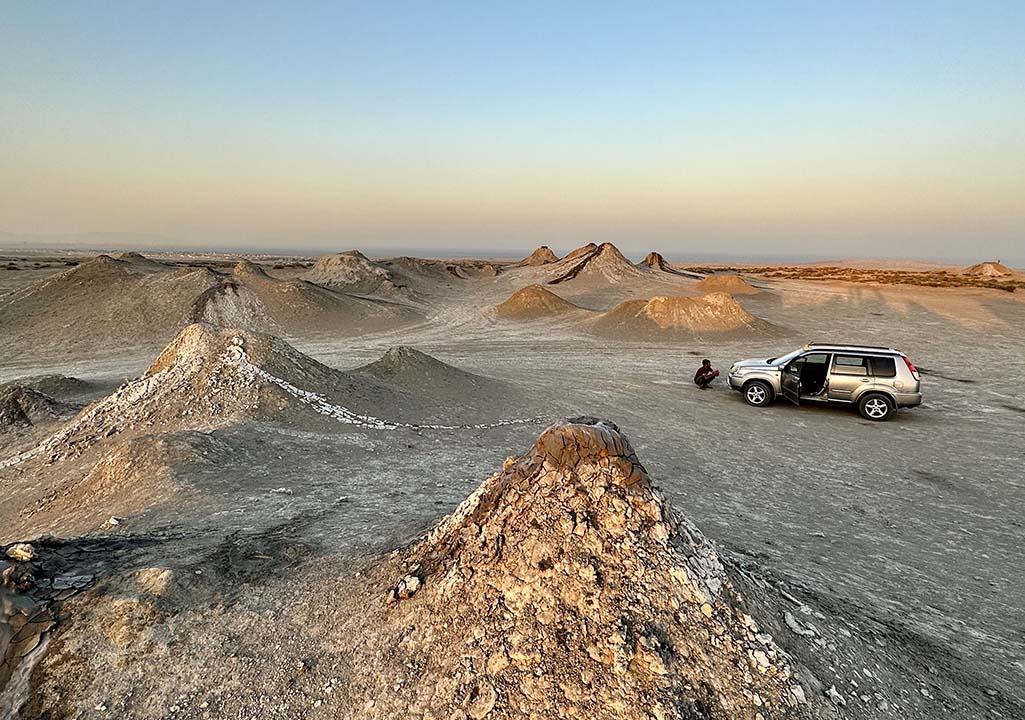
|
|
|
One more stop on the drive back to the city: an after dark visit to the Bibi Heybat Mosque, containing the tomb and shrine the shrine of Ukeyma Khanum. The building dates only to 1990, being a recreation of the original 13th century edifice destroyed by the Communist regime.
|
|
|
Time to head out of town. First stop is the 15th century mausoleum of Diri Baba and adjacent cemetery.
|
|
|
|
|
Then, the 8th century Juma Mosque at Shamakhi.
|
|
|
On to the ancient copper-smithing and modern tourist town of Lahic.
|
|
|
We end up in Sheki. Formerly the seat of an independent Khanate, it features a palace, a fortress, and a caravanserai.
|
|
|
|
|
Nearby Kish features a 12th century church and an odd monument to Thor Heyerdahl, Norwegian explorer of Kon Tiki fame who believed that Viking mythology was rooted in ancient Azerbaijan.
|
|
|
We drive to the border for the next stage, a land crossing into Georgia. As part of the worldwide Covid panic, the border is still closed with one loophole: foreigners may exit
(but not enter) the country by land . Our guide drops us off as close as he is able, where we are confronted with a seemingly endless walk hauling our luggage to the border post. There, we encounter a locked door. Knocking eventually results in someone coming to open the door and process us out. I venture to say we are their only customers the whole day. The other side of the border is only slightly less dormant but is where our Georgian guide is waiting to greet us.
Our first stop is Sighnaghi, a hilltop fortress town, where we spend the night and are introduced to the Georgian language, which is written in what appears to be the Martian alphabet.
|
|
|
|
|
|
In the morning we proceed to Bodbe Monastary, noted for its rose garden; unfortunately October is not a month to seek roses in bloom.
|
|
|
But in Georgia every month is the season for churches and monasteries. Next is the 5th century Nekresi Monastery complex, featuring what’s left of 500 year old frescoes.
|
|
|
|
|
But wait, there's more! Another ancient church dedicated to Tamir, 12th century queen of Georgia.
|
|
|
Since ancient Greece Georgia has been known for its wines. In Telavi we visit the Tsinandali estate and winery. There is an elegant manor house (no interior photos allowed) and a cellar holding vintages dating back to 1874. Makes for great photos, but, in truth, early in the 20th century those bottles considered still drinkable were sent to the Czar's court for consumption.
|
|
|
|
|
We visit yet another winery for an actual tasting session. They, too, have photogenic cellars.
|
|
|
In the Caucuses, there is no escaping history or politics. The registration form for our hotel that night contains the following verbiage: “With my signature below, I acknowledge that Russia invaded Georgia and is currently occupying 20% of Georgia!”
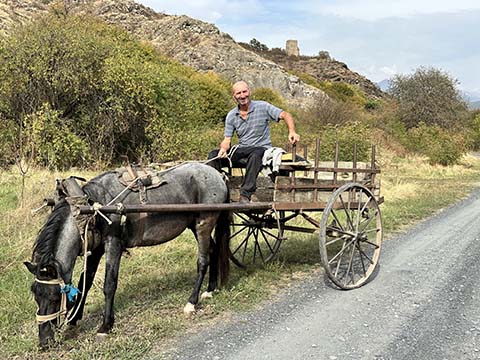
Telavi also has an old fort/castle and a colorful market.
|
|
|
Continuing on, we stop at Ujarma Fortress, now mostly in ruins.

Then Mtskheta, considered the Jerusalem of Georgia, home of Svetitskhoveli Cathedral, Jvari monastery, and Samtavro convent, all 1000 and 1500 years old.
|
|
|
|
|
As the sun is setting we reach Tbilisi. Our first stop is the modern Chronicle of Georgia. From its hilltop location one can look down on Soviet-era apartment blocks.
|
|
|
|
|
|
Tbilisi is another city much transformed from its recent past.
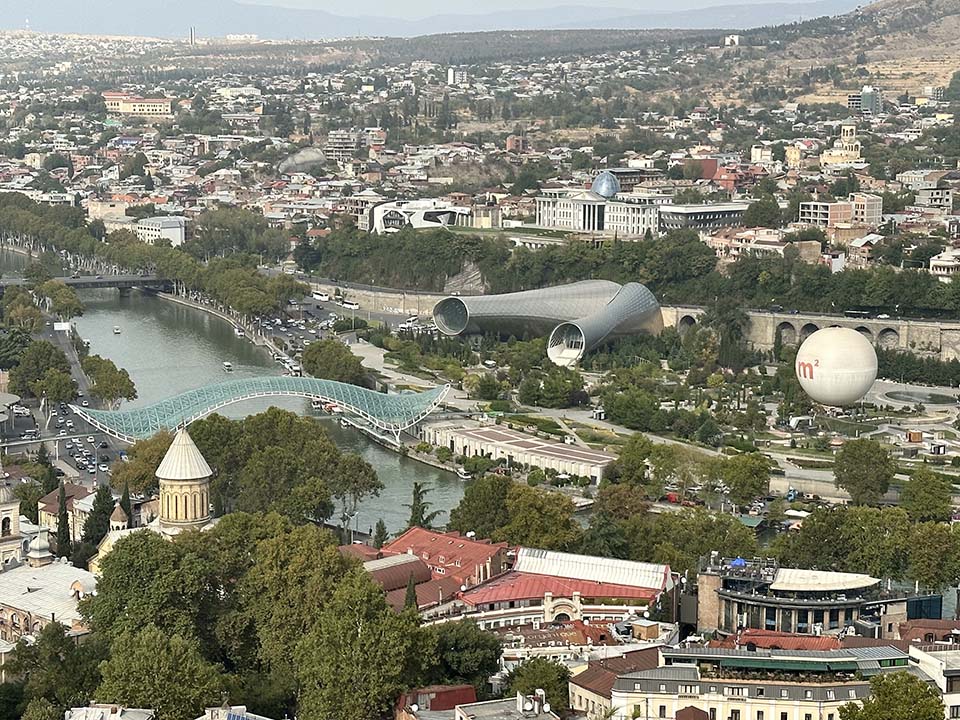
From my last visit I remember empty churches and monasteries. They have since reopened, the old town revitalized and restored, and many new structures added. Two days here not enough to see it all.
|
|
|
As we head out of town to continue our tour we stop to visit Ananuri fortress, which, of course, is also a religious site.
|
|
|
Along the road, in the middle of nowhere is a Soviet-era monument to Russian-Georgian friendship (hah!)
|
|
|
We are heading to Stepantsminda, a/k/a Kazbagi, and Gergeti church, at 2200 m the highest in Georgia.
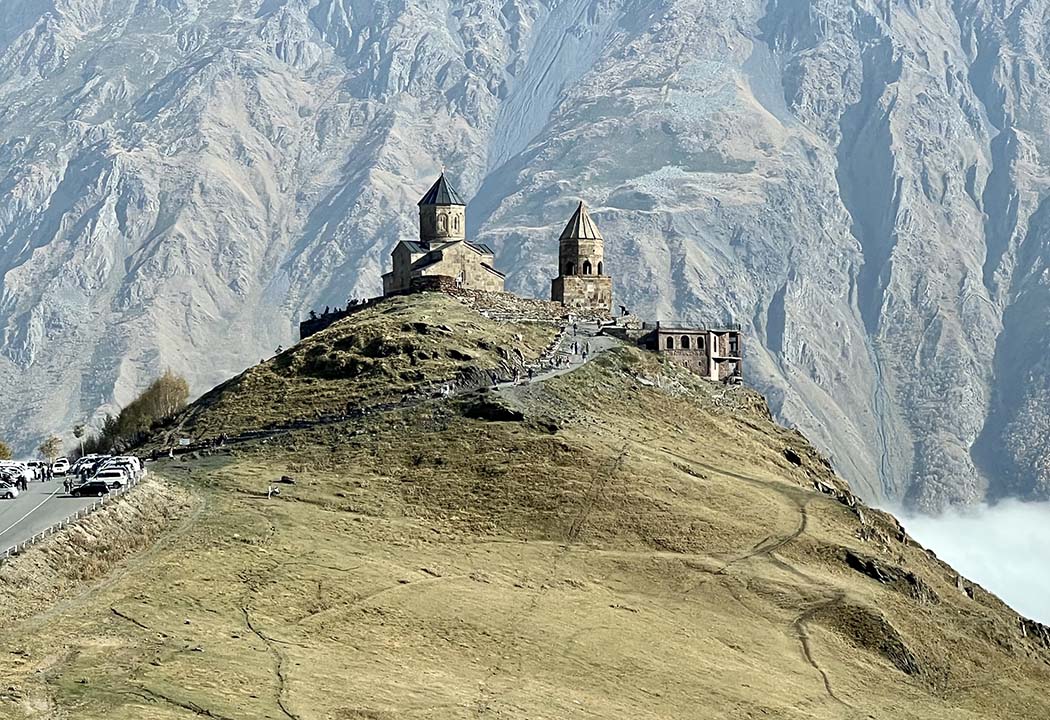
Its interior is by now familiar, but the hilltop location affords views of the surrounding countryside.
|
|
|
|
|
We ontinue along the historic Georgia Military Highway, the historic route across the high Caucuses, to the border with Russia. Overlooking the final pass is (shocker!) another monastery.

Sunrise from our hotel brings a gorgeous vista of Kazbegi Mountain and Gergeti.
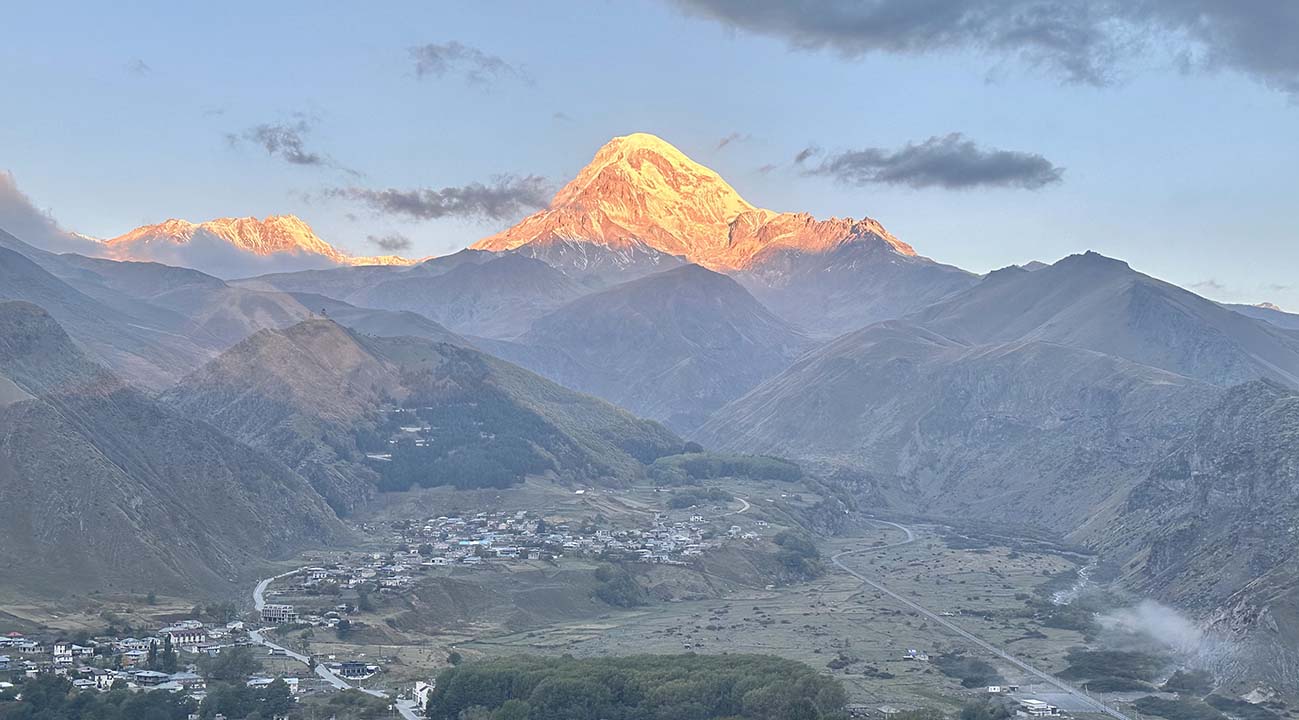
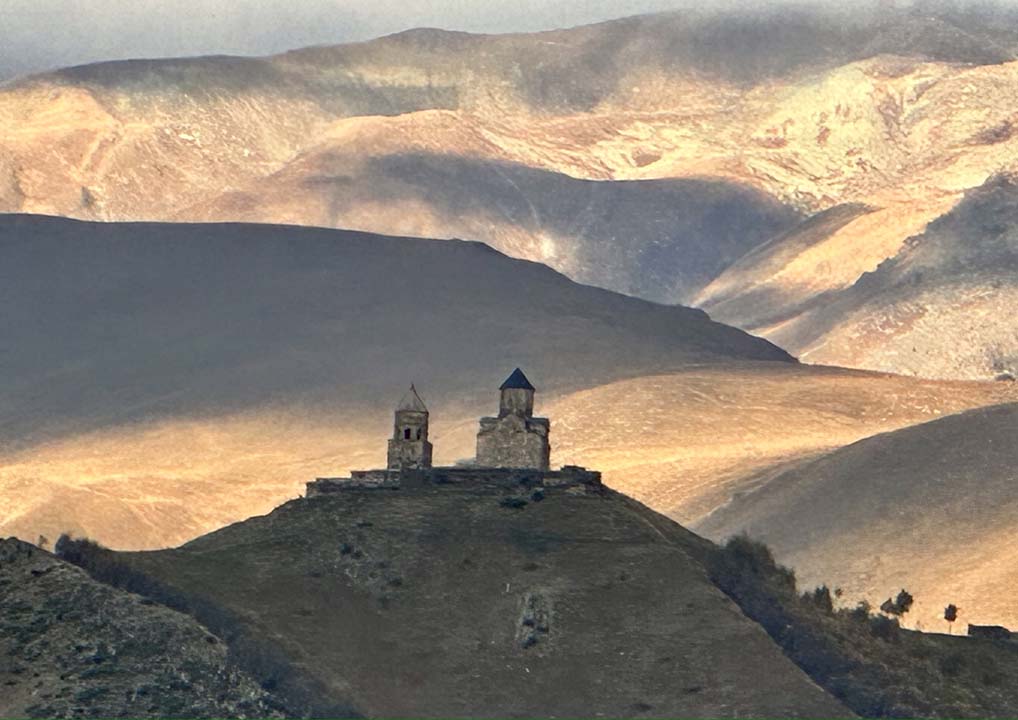
Just out of town a local artist is singly-handedly creating Georgia’s answer to Easter Island.
|
|
|
For me, a must is a return visit to Gori and its “local boy makes good” museum of hometown hero, Uncle Joe Stalin. His 20 ft tall bronze statue (the last surviving one in the USSR) was taken dowin in 2010 and only a more modest one remains. The current exhibits try to present a somewhat more balanced portrayal of his reign of tyranny, but many of the truly kitsch objects are still on view.
|
|
|
|
|
Gori also has a high castle, below which are a set of sculptures relocated from Tbilisi.
|
|
|
After that, the historic spa town or Borjomi, where the eponymous water is bottled. People have been coming here since Czarist days to imbibe the foul-tasting sulpherous liquid.
|
|
|
In the nearby city a few example of Soviet public art survive.
|
|
|
|
|
We are behind schedule, so a planned visit to Rabati fortress is reduced to a drive-by.
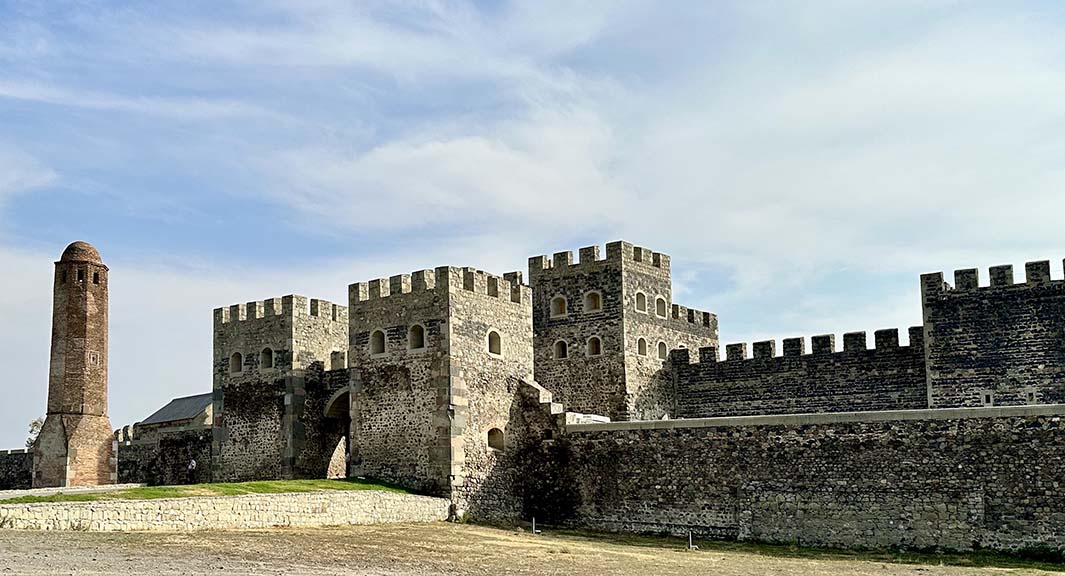
We are on our way to the Vardzia caves, a medieval monastery complex.

|
|
|
|
|
The next day on the drive to the Armenia border we encounter a railroad car repurposed as a bridge, a cemetery, and yet another church, Manglisi.
|
|
|
|
|
Trip date: September-October 2022